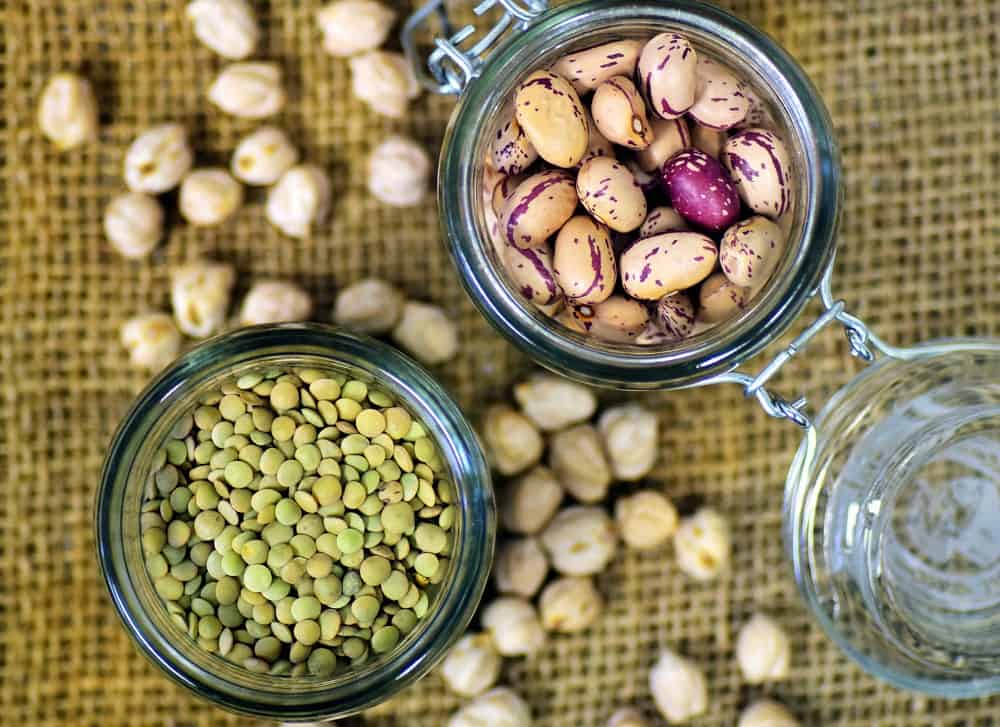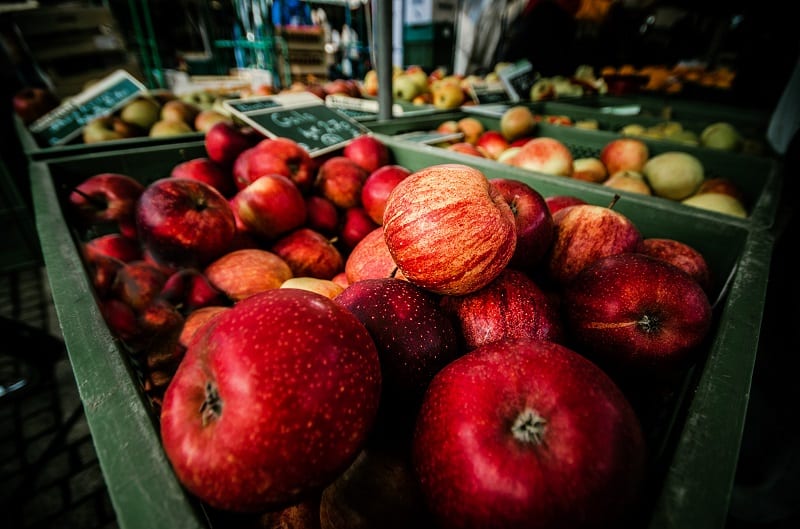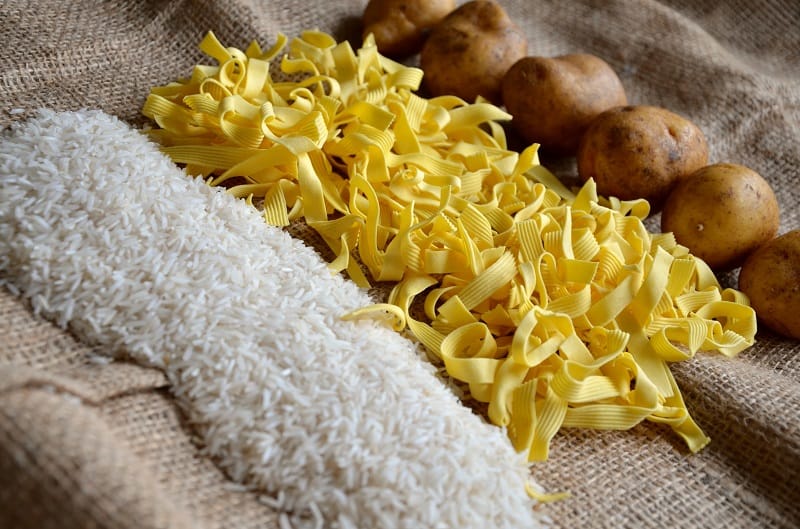People tend to have a common misconception that eating a healthy plant-based diet is more expensive than eating the standard Western fare. Fortunately, eating healthy can be very affordable, but if you are not careful, it can also get a little pricey.
Below are 40 helpful tips I have learned through my own experience on a plant-based diet, or from ideas I came across on the web while researching this article. I included a comprehensive list of ideas and tables for those who are newcomers to a healthy plant-based lifestyle.
1. Put leftover or nearly expired fruit into smoothies. You won’t even notice they have reached their expiration when processed with other plant foods such as nut-milk and chia seeds. The riper a fruit becomes the higher its sugar concentration increases, and thus, the sweeter your smoothie will taste.
2. Use leftover or nearly expired veggies for soup or bases. Similar to the expired fruit in the previous description, you can throw veggies that have nearly gone bad in a food processor or blender to mix up as a soup base. Blend on high for a creamy base or on low for a short period for a more hearty base. These can also be thrown in the freezer for later use.
3. Make your own soup broth. Commercial soup broths can be pricey and full of sodium. When boiling or steaming veggies simply save the water in a mason jar of some sort and voila! Free soup broth. It’s actually quite flavorful, also.
4. Buy dried goods in bulk. This includes items like lentils, beans, dried fruit, grains, nuts, and seeds. If your local grocery store doesn’t have a dried goods, or bulk section, these items may be located in ethnic aisles or online.
5. Make your own granola and dried fruit. This will require the use of a dehydrator, but you can find them fairly cheap online or at a home-goods store. Mix the dried fruit in with some baked rolled oats, nuts and seeds, cinnamon, and a little maple syrup and you will have some delicious homemade granola.
6. Grow and dry your own herbs. This can easily be done in a windowsill if you don’t have space for a garden. You can have fresh or dried herbs depending on your preference. You could even ground them into a powder or freeze them for later use.
7. Make your own nut-milks and nut-butters. Nut-milks are super easy to make. Just soak the nuts in some hot water for about 20 minutes, then put these together in a high-powered blender to mix them up until milky. Nut-butters are similar. Just remove the water before blending.
8. Grow your own food! It’s not always easy to find the space for a garden in a big city, but community gardens are becoming more common. You could also use the windowsill tactic for smaller plants.
9. Use grocery reward systems or become a member of a co-op. Fresh seasonal produce is often used in grocery store reward systems. This allows the owners to move large quantities quickly at a cheaper rate for the consumer. It’s a win-win. Co-ops are also becoming more trendy. Here, you will likely pay a low annual fee to get member discounts on all the store items.
10. Soak and cook your own beans. Dried beans are a mere fraction of the cost of canned beans. You also don’t have to worry about added salt or BPA from can liners. Make these a staple in the majority of your meals and you will not only save a ton of money but drastically improve your health and longevity.

11. Use customary coupons. This may seem obvious, but it is a tried and true method for any savvy shopper. Check the store’s website prior to shopping for deals.
12. Make your own teas and coffee. With a Starbucks or similar coffee shop on most city blocks, people become quickly accustomed to the luxury of premade teas and coffees. By making them at home, you could save an average of $1,200 per week assuming you drank one ready-made drink at least 5 times per week all year round. You would also save your body from the vast amount of syrup and added sugars they tend to put in those drinks.
13. Buy produce in season. This one can be tough when you have a recipe that calls for items that are not in season. There are actually many recipe sites that feature seasonal recipes if you are interested. You can also find which fruits and veggies are in-season by clicking here.
14. Shop around. I often find myself shopping at two to three main grocery stores within a given month. This is helpful not only for saving money, but also for finding those rare items you may need for a particular dish.
15. Make your own hummus. Homemade hummus is so much more flavorful than store-bought kinds because it is fresh and doesn’t contain any unwanted preservatives. Blend some chickpeas, add garlic, onions, and a little cumin and you have your very own hummus.
16. Buy specialty and bulk items online. Purchasing groceries online can be tricky when a lot of your calories are coming from fresh produce. On the flip side, buying dried goods in bulk online is a great money saver. Personally, I prefer to buy specialty items online, also. Like flavored vinegars, for instance.
17. Eat unprocessed whole foods. Don’t get sucked into those vegan convenience foods if you can help it. They are not only pricey but filled with junky ingredients that make them practically identical to non-vegan junk food. Remember, “vegan” is not synonymous with “health food”.
18. Make an unprocessed list. This is the single best way to avoid impulse-buys. Making a weekly grocery list does necessitate some additional time and forethought, but after you do it several times it’ll become second-nature.
19. Keep your pantry stocked. Load up on dried goods like lentils, beans, quinoa, rice, teff, oats, nuts, seeds, and dried fruit whenever these items are on sale. They can be kept for months when stored properly in a cool dark place.
20. Browse the clearance items at the grocery store. Grocery stores are finally becoming more progressive with their damaged or nearly expired produce and other items. Search for specialized “clearance” sections that can usually be found when you first enter the produce. You can use these items as soups bases or smoothie ingredients as I described in #1 & #2 on this list.

21. Visit the farmer’s market at the end of the day. This is a great way to find local seasonal produce. Show up near the end of the day when farmers are trying to sell out their remaining supply. They tend to give discounts on any leftover items they were unable to sell during the day.
22. Plan out your meals for each week and meal prep. When you fail to plan your meals and snacks you are left with more random items that tend to go bad before you get a chance to eat them. Plan your meals around dried goods that keep well for months in your pantry. Then all you really have to do is plan what fresh produce to purchase that will go well with each starchy pantry item.
23. Freeze leftovers or nearly expired produce to be used for later. This is a great way to get the most out of your grocery items. No matter how much planning you do, there will always be unforeseen events that can derail your careful preparations. Freeze anything you know will go bad if you don’t. Be sure to freeze leftovers within 3-4 days of preparation.
24. Buy frozen fruits and veggies. Fresh fruits and veggies can lose their freshness and their nutrient content during long shipments across oceans and continents. Frozen fruits and veggies actually retain their freshness because they are frozen directly after being harvested.
25. Dine-in. It is almost five times more expensive to order delivery from a restaurant than it is to cook at home. Plus, after eating whole-food plant-based for 1 to 3 months your tastebuds will adapt and become more sensitive to the subtle flavors in plain natural foods. Pretty soon, you will easily prefer making your own meals due to the heavy use of salt, sugar, and oil used in restaurant food.
26. Make your own travel snacks. Convenience foods are the most tempting when traveling. With a little extra planning and effort, you can make your own travel snacks. Granola, trail mix, popcorn, dried fruit, nuts and seeds, and cut up fruits and veggies are my usual go-to’s when my family is on the road or in flight.
27. Prep all your own work and school lunches. My family grocery shops on Saturdays and carries out the meal prep-work on Sundays before the busy week starts. Gather enough Tupperware to organize all five of your lunches and your children’s’ lunches for the week. Modern Tupperware does a fairly good job of keeping your greens and other prepared produce fresh all week.
28. Take a cooking or baking class. Expanding your kitchen skills will make food preparation more enjoyable for you and your family members. Learning the cooking basics will also allow for easy substitution of expensive recipe ingredients. And although I’m a bit of a whole-foods purist, the baking will come in handy for constructing “healthy” homemade birthday cakes.
29.Purchase more low-cost items. Focus especially on less expensive produce. Items such as bananas, carrots, cabbage, and potatoes are consistently some of the cheapest plant-based items in the produce section. Scroll to the bottom of the list to see tables that outline the 14 least and most expensive produce items.
30. Make starches the base of every meal, such as beans, rice, squashes, potatoes, and other grains. Not only are these some of the least expensive items in the grocery store, but they are packed full of major nutrients, vitamins, minerals, fiber, and thousands of different phytochemicals.

31. Quantity discounts. Pre-packaged multi-pound bags of apples, potatoes, and carrots, for instance, tend to offer good value over their loose counterparts, with no sacrifice in quality.
32. Make your own salad dressing and dips. This is not only a money-saver, but a great way to keep added sugar, salt, and oil out of your diet. Most tasty plant-based dressings and dips are made from just about any mixture of the following ingredients:
- Tahini
- Nuts (blended)
- Seeds (blended)
- Avocado
- Other fresh fruit/veggies
- Miso
- Low-sodium soy sauce
- Bragg’s amino acids
- Date paste (or whole dates blended)
- Maple syrup
- Vinegar (white, red, apple cider, balsamic, fig, blood orange, etc.)
- Brown spicy mustard or Dijon
- Spices/herbs
33. Raise your kids on healthy, unprocessed plant-based foods. People feel that there is some rule that says kids must eat processed junk in the form of crackers, ice cream, candy, breakfast cereal, pizza, fast-food, soda, cake, and doughnuts. During the most crucial time in a person’s development, nourishing whole plant foods provide the macro AND micronutrients necessary for strong bones, organs, and minds. Only you can decide what foods are available to your kids day after day, year after year. Teach them healthy habits while they are young so they can grow up utilizing those healthy habits for 50+ years into their adulthood.
34. Do your own chopping. Don’t be swayed by purchasing pre-chopped fruits and veggies. These will be much cheaper when prepared at home. If you really need a time-saver, consider using frozen pre-chopped items. These tend to be fresher and contain more nutrients as well.
35. Purchase a Community Supported Agriculture (CSA) share. This usually comes in the form of a membership or subscription to a local farmer during your region’s harvest season. You sign up before or during the planting season and pay a set price that may be shared with one or two other members. The farmer will drop off a predetermined amount of produce each week depending upon what was harvested. This way, you are guaranteed fresh, in-season produce throughout the season. Click here to find a local CSA in your area.
36. Make your own salsa, pico de gallo, and guacamole. These are very quick and simple to make in your own kitchen. Avocados can get expensive during the offseason, however, so maybe stick to salsas during those months.
37. Buy nuts sparingly. This is one of the most expensive plant-based purchases. Although they are full of healthy vitamins, minerals, fats, and phytochemicals, they can really set you behind in your weekly grocery budget. Opt for seeds as an alternative rich fatty acid source every other week or so.
38. Buy organic only for those items that tend to have the highest amount of pesticide residue. To find a complete list of the “dirty dozen” and “clean 15” in your area visit the Environmental Working Group’s website by clicking here.
39. OR Don’t purchase organic items at all. Now, of course, you should buy organic food if you can afford it and have access to it. But, there are certain instances where these are simply unaffordable for some folks. In those situations, it is better to eat non-organic fruits and vegetables than none at all. The only caveat is where you may be feeding an infant. Infants need organic foods because they are not as capable of ridding their bodies of harmful toxins as adults.
40. Don’t use recipes. Many recipes ask for ingredients that you may only use once or twice before they spoil. And some such ingredients can get pretty pricey. Keep it simple and only purchase items you are sure to use. Plant-based eating has such a great variety of inexpensive items that you really don’t require fancy concoctions.
The tables below compare the most expensive to the least expensive fruits and veggies. This will assist you in making decisions about which produce items are within your budget during a given week. The data is courtesy of the USDA.
Most Expensive Fruits & Vegetables
| Most Expensive Fruits | Average Cost per Cup | Most Expensive Vegetables | Average Cost per Cup |
|---|---|---|---|
| Raspberries | $2.29 | Asparagus | $2.47 |
| Blackberries | $1.89 | Artichoke | $2.43 |
| Blueberries | $1.48 | Corn | $2.20 |
| Pomegranate | $1.27 | Okra | $1.75 |
| Apricots | $1.21 | Spinach | $1.64 |
| Cherries | $1.19 | Cherry tomatoes | $1.43 |
| Kiwi | $1.11 | Acorn Squash | $1.10 |
| Dates | $0.91 | Turnip greens | $1.07 |
| Strawberries | $0.85 | Mustard greens | $0.98 |
| Tangerines | $0.82 | Avocado | $0.96 |
| Grapes | $0.77 | Brussels sprouts | $0.95 |
| Plums | $0.77 | Cauliflower | $0.89 |
| Honeydew Melon | $0.67 | Summer squash | $0.85 |
| Oranges | $0.66 | Broccoli | $0.84 |
Least Expensive Fruits & Vegetables
| Least Expensive Fruits | Average Cost per Cup | Least Expensive Vegetables | Average Cost per Cup |
|---|---|---|---|
| Watermelon | $0.20 | Dried pinto beans | $0.17 |
| Bananas | $0.28 | Potatoes | $0.20 |
| Cantaloupe | $0.38 | Dried lentils | $0.22 |
| Apples | $0.44 | Dried black beans | $0.24 |
| Pineapple | $0.47 | Dried navy beans | $0.24 |
| Peaches | $0.60 | Dried blackeye peas | $0.24 |
| Pears | $0.61 | Carrots | $0.24 |
| Papaya | $0.64 | Cabbage | $0.26 |
| Oranges | $0.66 | Iceberg lettuce | $0.28 |
| Nectarines | $0.66 | Romaine lettuce | $0.33 |
| Honeydew Melon | $0.67 | Lima beans | $0.34 |
| Mangoes | $0.68 | Cucumbers | $0.34 |
| Plums | $0.77 | Celery | $0.40 |
| Grapes | $0.77 | Onions | $0.41 |
For further insight on the several ways in which a plant-based diet is cheaper overall than the standard Westernized way of life, click here to visit my earlier post titled Is Eating a Plant-based Diet is More Expensive?.
Karli Jackson

